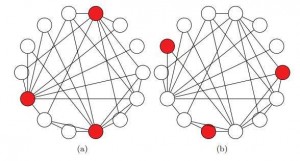
Could Facebook one day be Brainbook? Mark Zuckerberg said in a recent Q&A that he predicts people will send thoughts and experiences to each other as easily as people text and email today. However, this fanciful idea of brain-to-brain communication is still a long ways off, neuroscientists say.
On Tuesday (June 30), in response to a question about the future of Facebook during an online Q&A with users, CEO Zuckerberg replied: “One day, I believe we’ll be able to send full rich thoughts to each other directly using technology. You’ll just be able to think of something and your friends will immediately be able to experience it too if you’d like. This would be the ultimate communication technology.”
Zuckerberg continued, “We used to just share in text, and now we post mainly with photos. In the future video will be even more important than photos. After that, immersive experiences like VR [virtual reality] will become the norm. And after that, we’ll have the power to share our full sensory and emotional experience with people whenever we’d like.”
He is referring to an advanced form of brain-to-brain communication in which people could plug in, similar to a VR headset, perhaps with some kind of actual physical connection to the brain itself. Brains transmit information between neurons via a combination of electrical and chemical signals, and it’s possible even now to see them via functional magnetic resonance imaging (fMRI), electroencephalograms, and implanted electrodes. So theoretically it is possible to encode those signals into bits just as we do with digital phone signals, and send them to another person for decoding and “playback” in another brain.
Reading the mind
From a purely technical standpoint, it’s possible to “read” a person’s brain activity and get a sense of what that person is thinking, said Christopher James, professor of biomedical engineering at the University of Warwickshire in the U.K. Functional magnetic resonance imaging, electrodes attached to the scalp, or implanting electrodes into the brain can all work to reveal something about brain activity in real-time. But right now the only way anyone knows of to get the precision required to pick up thoughts and feelings is with the electrodes. Imaging technologies and scalp-mounted electrodes can’t resolve areas small enough to know what’s going on at the cellular level, and scalp electrodes can only detect relatively “loud” signals that get through the skull.
But reading the signals is only half the battle. Decoding them is another matter. There’s no single brain area that governs thoughts of a given type; the way a person experiences thinking involves many parts of the brain operating simultaneously. Picking up all those signals that make up a thought in a real brain would require sticking electrodes into lots of different areas.
“We’d have to eavesdrop in many locations — some of them deep. If we did know minutely where to place electrodes there’s going to be a heck of a lot of them,” James told Live Science. “Then we need to make sense of those impulses,” he added, referring to the electrical signals picked up by the electrodes. [Incredible Technology: How to See Inside the Mind]
With the computing power available today scientists could probably make sense of the complex pattern of electrical signals, that is, if they knew exactly what those signals meant. However, that’s far from clear. A person’s thoughts are more than the simple sum total of voltages and currents. Which impulses come first, and in what pattern, and how intense they should be is still a mystery.
James noted that deep brain stimulation, which is used to treat Parkinson’s and epilepsy, involves sending simple signals to specific parts of the brain. But even such a straightforward treatment doesn’t help every patient, and nobody knows why. And thoughts are a far more complex phenomenon than treating Parkinson’s, he said.
Andrew Schwartz, a neurobiologist at the University of Pittsburgh, said the whole problem with any such concept of brain-to-brain communication is that nobody knows what a thought actually is. “How would you recognize a thought in the brain if you cannot define it?” Schwartz said. “If you replace ‘thought’ with intention, or ‘intention to act,’ then we may be able to progress as there is gathering evidence that we can recognize that in brain activity. However, this is very rudimentary at this point.”
Steps to Zuckerberg’s vision
Scientists have conducted several experiments with sending simple bits of data from one brain to another. For example, at the University of Washington a team demonstrated communicating between two brains via the motor cortex — a person with electrodes on his head sent brain signals via the Internet to the motor cortex of another person in another room. The brain information signaled the person receiving the message to move his hand and control a video game.
Starlabs in Barcelona showed that it’s possible to send a rudimentary word signal over the Internet. In that case the sender would think of a word, and the receiver would have the visual cortex stimulated by a magnetic field as the signal came in. The receiver would see flashes and could then interpret the word.
At Duke University scientists have experimented with motor impulses between rats. They linked two rats’ brains. One rat got a reward for hitting one of two levers when a light came on, the other had the levers but no light cue. The second rat was able to hit the correct lever more often than chance whenever the first rat was given the signal to press its lever. [Video – Watch Man Wiggle Rat’s Tail With His Mind Only]
Neuroscientists have even recreated movie clips by looking just at a person’s brainwaves; That mind-reading method, however, was limited to areas of the brain linked to basic visualization and not those areas responsible for higher thought.
James noted that in all these cases the information has been very simple, essentially bits of ones and zeros: When a person thinks about opening a door, they know what a door is, what a handle is, that the hand needs to reach the door handle to open it. That all happens before that person gets to moving arms and grabbing the doorknob.
Challenges ahead
Even with those successes — or at least proofs of concept — progressing to a technology that could transfer a person’s thoughts and feelings to another person is still a ways off, said Andrea Stocco, a research scientist at the University of Washington who took part in the motor cortex experiment. Many brain scientists think similar patterns of neural activity should correspond to similar thoughts in different people. But beyond that, nobody can predict exactly what patterns might be linked to a given set of thoughts. So far scientists can only discover these patterns by experimenting. [The Top 10 Mysteries of the Mind]
He added that while the technology is in theory available to record impulses in great detail from the brain, in practical terms placing that many wires into a brain to “see” that activity is quite risky. “We do not currently have the technology to record from enough cells in the brain to decode complex thoughts,” he said.
The other problem is an ethical one, James said. An experiment involving hundreds of electrodes inserted into a brain isn’t something any institution would be likely to approve, even with volunteers. He noted such experiments with inserted electrodes tend to be done on people who already have some kind of problem – epilepsy or Parkinson’s disease. (The University of Washington and Starlabs experiment didn’t involve invasive surgery).Those patients are getting electrodes inserted into their brains already. Even then, the data they yield is often crude.
“It’s a bit like having a football stadium with a crowd of people, and putting a microphone outside the door and trying to pinpoint one conversation. The best I can hope for is to get half of them to shout in unison.”
And unfortunately, the only way to know whether such a brain-to-brain interface is working is to work with a sentient creature — a person. In an experiment done on a rat the rat can’t tell us what it is feeling except in simple ways like having the rat hit one lever or another. That isn’t anything close to what humans experience. And it’s important because there’s a very real question of whether such stimulation induces experiences (known as qualia) in the rats, said Giulio Ruffini, CEO of Starlab,
It’s also far from clear what the long-term effects on the brain would be — scarring from electrodes would be just one problem. “The brain doesn’t like getting things stuck into it,” James said.
Schwartz added that motor impulses are one thing — there have been some successes there with prosthetic limbs, for instance. But that is nothing like the “rich experiences” Zuckerberg describes. “There is no scientific data showing that it can be extracted from brain activity,” James said. “Despite many claims about activating particular brain ‘circuits,’ this is almost all wishful thinking and has not been done in any deterministic manner to product a perceived experience. We simply haven’t done the science yet.”
Stocco, though, was somewhat optimistic about Zuckerberg’s vision. “His scenario is far, but not unreachable,” he said, as the kinds of advances necessary are at least imaginable. “We could get there, given adequate work and knowledge.”
References:http://www.livescience.com/




